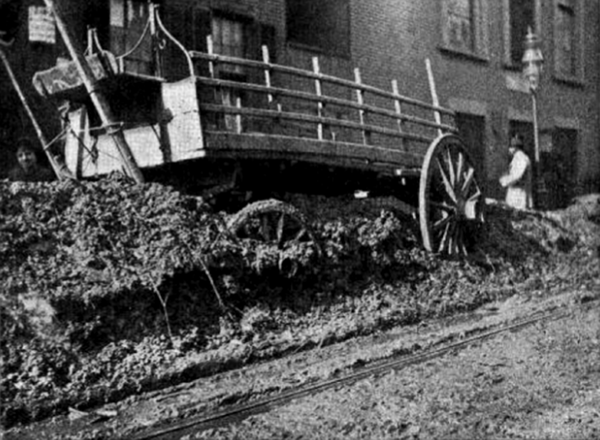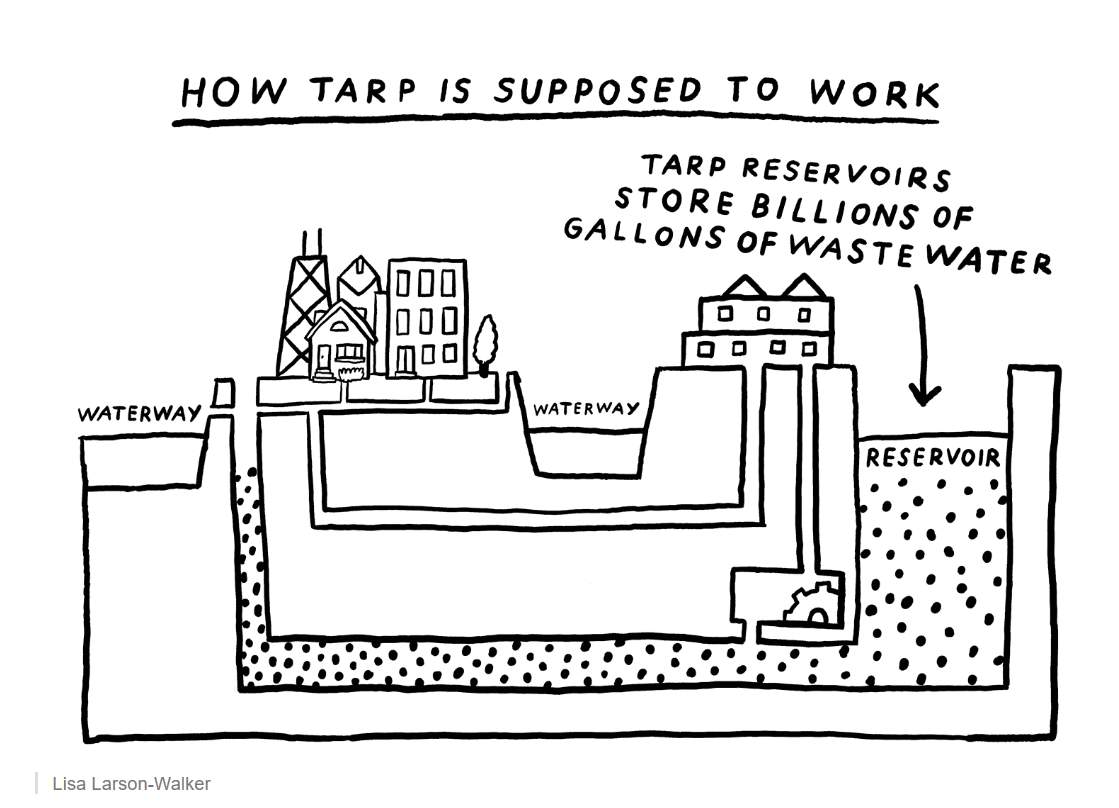When I was a kid one of my favorite museum tours in Paris was the Musée des égouts de Paris – the sewer museum. Paris’ sewers go back a long way; they were semi-open rivers of effluent, like the Thames in London or the Cloaca Maxima in Rome; often these were rivers that were thoroughly ruined then built over and forgotten as long as the nasty stuff flowed the right direction.
[I seem to be interested in mountains of poo: stderr and “4 stories of shit” stderr let’s just say it’s a metaphor, shall we?]

NYC, 1890
My posting about The Great Poop of London must have perturbed the artificial intelligences that feed me news because I’ve gotten a rush of references to poop. At least that’s better than when I start fact-checking the torture program, or researching nuclear weapons.
Anyway, here’s a fascinating article that came up in Slate, about the Chicago river, and the sewers under that great city. [slate]
The sewer engineer’s riddle: What do you get when you mix a gallon of sewage and a gallon of rainwater? Two gallons of sewage.
Naturally, sewer engineers have their own culture, and their own jokes. It must be a fascinating fraternity, who know where everything is and who go down into the secret city below the city. And, every city’s different. For example, did you know that San Francisco has parts of the city that are built over the skeletons of ships that gold rushers arrived in? They sank into the mud and became infrastructure.
One of the most fascinating things I learned about sewers, when I was a kid, was “pigging” the lines. Basically, you have a round sewer, and sometimes it might need to be cleaned out. Let’s say the sewer goes under the Seine River – it’s way too dangerous for a person to go down there under any circumstances (would you trust “OK, we have it shut off, you run down there and shovel out the shit and if you hear us yell “run!” you hightail it out of there!”) so you force a gigantic fairly well-fitting cork ball in one side and let the suction pull it through, pushing a mountain of stuff into a gigantic stuff volcano on the other side, like some sort of champagne cork from hell. The museum even mentions the notable time that the cork got stuck and they let the water build up so they could put some dynamite on a long pole and blow it clear. Poop plus dynamite plus water as a tamper! I am sure that the ancient Roman sewer engineers would have immediately understood the whole thing, and been green with envy.

[slate] The Chicago Pipe
That’s because Chicago built a second river, an infernal reflection of the first, tracing its course hundreds of feet below ground. On rainy days, this subterranean passage, a conduit that can hold more than 1 billion gallons of wastewater, welcomes a roaring torrent of shit, piss, and oily runoff from the downtown streets. This megasewer, a filthy hidden portrait to the Chicago River;s Dorian Gray, is dynamic enough to create its own wave action if not properly supervised. That’s what happened on Oct. 3, 1986, when a geyser blasted through a downtown street, lifting a 61-year-old woman’s Pontiac Bonneville into the air like a toy, nearly drowning the driver in dirty water
It may be full of poop and whatnot, but water’s still very heavy and obeys physical law. What goes up, comes down, etc. Most importantly, about water is that it’s not compressible. If a million gallons of water falls on a city the size of Chicago, all that water’s got to have someplace to go. Hint: it’s great for diluting the mess in the sewers.

The whole article is framed around the question of “what happens if there is too much rain?” Well, that is a problem. I loved the illustrations that show, basically, that no matter how you slice it the water’s got to have somewhere to go because once it finds its level, that level had better not be your basement.
When Lori Burns was growing up on the South Side of Chicago in the 1980s, she always kept an eye on the dip Stony Island Avenue took under the freight tracks on 95th Street. “We knew that if it was flooded, we’d have water.” Her parents’ basement, once a cozy retreat with a radiant-heating floor, was transformed into a semiannual biohazard zone. The house flooded while Burns’ mother was in treatment for breast cancer, in 2004 and 2007. It flooded again in 2008, 2011, and 2013, ruining the washing machine, boiler, and hot-water heater. After she inherited the house, Burns spent more than $10,000 on flood-proofing. “For most African Americans, that house is the biggest asset you have,” says Burns, who is black. “And if it’s being ruined from the bottom up, that’s not OK.”
[Included that as a reminder that ‘infrastructure’ spending in the US is also horribly racist]
Overall, my take-away lesson is that when you build big sewers, they handle normal problems just fine but there’s always a failure-point which results in catastrophic blowback. The trick is to build that failure-point with vision and foresight.
The article also has some deep thinking about the fundamentals of engineering:
“It’s a marvel,” Hobbs adds. “But we have this tendency in this country to think we can build our way out of stuff. And we can’t always build our way out.”


In Moria, in Khazad-dûm, the elves pumped all their shit. What, did you think high elves don’t poop?
There are amazing sewers under Tokyo, which must have inspired the Moria scene.

I want to observe a Senkai Juku performance there. Gods, please make this happen.
A guy I used to hang out with was an “urban explorer” whose hobby was going into places where you’re not supposed to go. His greatest accomplishment was getting into some of the spillways around Niagra Falls. He had some amazing pictures. Not my idea of fun, fast-roping around in the dark, with your ear cocked for the sound of a great big toilet flushing.

What were the elves doing in Dwarrowdelf… besides pooping?
My civil engineer friend from long ago claimed that the standard unit of velocity in the sewer business was “furlong per fortnight.”
DonDueed@#1:
What were the elves doing in Dwarrowdelf… besides pooping?
Elrond didn’t poop. That’s why he has that expression in the movies. True fact, they suppressed it.
coragyps@#2:
That’s really interesting. I guess the stuff is mighty thick.
I read some account about the Thames being nearly traversible on foot in some places, because it was so thick with … stuff.
Marcus @3: Guess I missed that part in The Silmarillion.
I still want to know why the elves were hanging out in the dwarfs’ delvings. Maybe you were referring to the olden days when elves and dwarfs got along, or maybe you meant Legolas… I could see him holding it for the whole traverse, at least up till they met the Balrog. At that point, all pants are off (for washing, of course…)
Her parents’ basement, once a cozy retreat with a radiant-heating floor, was transformed into a semiannual biohazard zone.
Which reminds me of a dark and stormy night in Aug ’89 when I was at Evanston Hospital attending my son’s birth. Streets were flooded as I made my way home and when I got there, the basement was starting to flood, eventually getting about knee-deep as I was trying to rescue as much as I could. Of course after this I learned the value of a standpipe in the basement drain. The sewer contents will get to its natural height in the standpipe and spare the basement.
Reminds me of the time the outlet sewer pipe to our house backed up. We’d had an end of summer barbecue with friends the night before and let’s just say that it was a long time before I ate corn again.
Makes me glad I live on the edge of a valley with no-one above me and no-one immediately below me. Crap overload is a very local issue, outside, where it belongs.
Here in Germany, the sewers are normally split into two systems, one for clean water from rain and creeks, and one for actual sewage. The systems are interconnected, so if heavy rainfall endangers the clean water system, it can overflow into the sewage system.
This has some drawbacks. For example are you not allowed to wash your car (or similar) on the street, to prevent oil and soap to reach the clean water system. The sewage system also need more cleaning, because it does not get regular rain washings.
On the other hand makes it the life of the water treatment facilities much easier, because the only have to treat a small portion of the water and when the clean water system overflows, it has far less sewage in it, which makes cleanup much easier.
Here in the UK we have separate sewer systems too. Waste water (toilets, sinks, baths, showers, dishwashers, washing machines etc) goes to the sewer, but drainpipes (which collect water from roofs, driveways and so on) are connected to the stormwater drains. The latter flow more or less directly into rivers, where untreated road runoff can cause problems. EU legislation increasingly requires treatment of road runoff to remove oils and heavy metals, so it’s a good thing that the UK is leaving those busybodies and can continue to dump whatever shit* they want into rivers.
* Literal shit should not get into stormwater, but an estimated 10% of houses in London wrongly connect some or all of their foul water pipes to rainwater drainpipes. And vice-versa. So when too much rainwater gets into the sewer system and the volume overwhelms the processing and storage capacity of the treatment plants, no points for guessing where the excess overflows.
That was not clear. Instead of “So when too much rainwater … the excess overflows”, please read “So, in addition to some of the shit going straight into rivers all the time, when too much rainwater … the excess also overflows”.
Also, the grues ate an (unnecessary, I hope) sarcasm tag around the bit about leaving the EU.